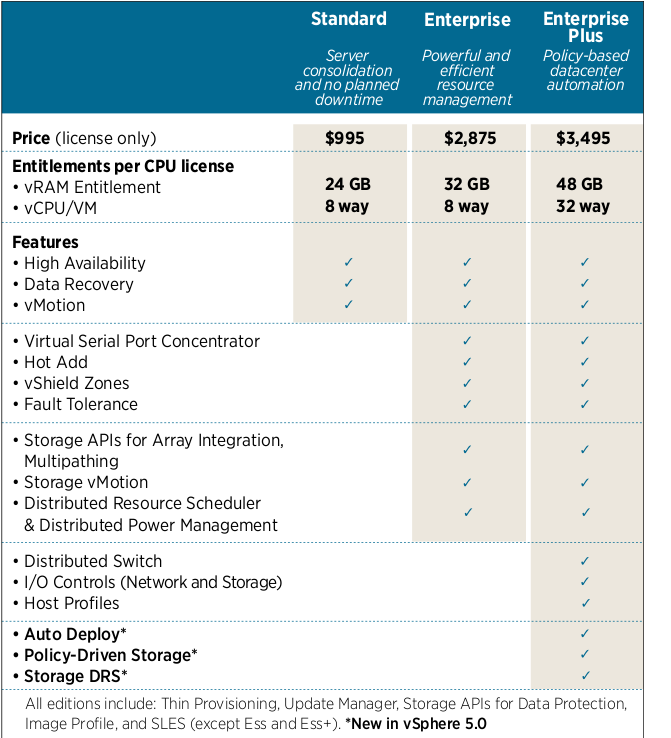Not exactly hot on the heels of Red Hat’s 260% price increase, VMware has done something similar with the introduction of vSphere 5 which is due later this year.
The good: They seem to have eliminated the # of core/socket limit for each of the versions, and have raised the limit of vCPUs per guest to 8 from 4 on the low end, and to 32 from 8 on the high end.
The bad: They have tied licensing to the amount of memory on the server. Each CPU license is granted a set amount of memory it can address.
The ugly: The amount of memory addressable per CPU license is really low.
Example 1 – 4x[8-12] core CPUs with 512GB memory
- vSphere 4 cost with Enterprise Plus w/o support (list pricing)Â = ~$12,800
- vSphere 5 cost with Enterprise Plus w/o support (list pricing)Â = ~$38,445
- vSphere 5 cost with Enterprise w/o support (list pricing)Â Â Â Â Â Â Â Â Â = ~$46,000
- vSphere 5 cost with Standard w/o support (list pricing)Â Â Â Â Â Â Â Â Â Â = ~$21,890
So you pay almost double for the low end version of vSphere 5 vs the highest end version of vSphere 4.
Yes you read that right, vSphere 5 Enterprise costs more than Enterprise Plus in this example.
Example 2 – 8×10 core CPUs with 1024GB memory
- vSphere 4 cost with Enterprise Plus w/o support (list pricing) = ~$25,600
- vSphere 5 cost with Enterprise Plus w/o support (list pricing) = ~$76,890
It really is an unfortunate situation, while it is quite common to charge per CPU socket, or in some cases per CPU core, I have not heard of a licensing scheme that charged for the memory.
I have been saying that I would expect to be using VMware vSphere myself until the 2012 time frame at which point I hope KVM is mature enough to be a suitable replacement (I realize there are some folks out there using KVM now it’s just not mature enough for my own personal taste).
The good news, if you can call it that, is as far as I can tell you can still buy vSphere 4 licenses, and you can even convert vSphere 5 licenses to vSphere 4 (or 3). Hopefully VMware will keep the vSphere 4 license costs around for the life of (vSphere 4) product, which would take customers to roughly 2015.
I have not seen much info about what is new in vSphere 5, for the most part all I see are scalability enhancements for the ultra high end (e.g. 36Gbit/s network throughput, 1 million IOPS, supporting more vCPUs per VM – number of customers that need that I can probably count on 1 hand). With vSphere 4 there was many good technological improvements that made it compelling for pretty much any customer to upgrade (unless you were using RDM with SAN snapshots), I don’t see the same in vSphere 5 (at least at the core hypervisor level). My own personal favorites for vSphere 4 enhancements over 3 were – ESXi boot from SAN, Round Robin MPIO, and the significant improvements in the base hypervisor code itself.
I can’t think of a whole lot of things I would want to see in vSphere 5 that aren’t already in vSphere 4, my needs are somewhat limited though. Most of the features in vSphere 4 are nice to have though for my own needs are not requirements. For the most part I’d be happy on vSphere standard edition (with vMotion which was added to the licensed list for Standard edition about a year ago) the only reason I go for higher end versions is because of license limitations on hardware. The base hypervisor has to be solid as a rock though.
In my humble opinion, the memory limits should look more like
- Standard = 48GB (Currently 24GB)
- Enterprise = 96GB (Currently 32GB)
- Enterprise Plus = 128GB (Currently 48GB)
It just seems wrong to have to load 22 CPU licenses of vSphere on a host with 8 CPUs and 1TB of memory.
I remember upgrading from ESX 3.5 to 4.0, it was so nice to see that it was a free upgrade for those with current support contracts.
I have been a very happy, loyal and satisfied user & customer of VMware’s products since 1999, put simply they have created some of the most robust software I have ever used (second perhaps to Oracle). Maybe I have just been lucky over the years but the number of real problems (e.g. caused downtime) I have had with their products has been tiny, I don’t think it’s enough to need more than one hand to count. I have never once had a ESX or GSX server crash for example. I see mentions of the PSOD that ESX belches out on occasion but I have yet to see it in person myself.
I’ve really been impressed by the quality and performance (even going back as far as my first e-commerce launch on VMware GSX 3.0 in 2004 we did more transactions the first day than we were expecting for the entire first month), so I’m happy to admit I have become loyal to them over the years(for good reason IMO). Pricing moves like this though are very painful, and it will be difficult to break that addiction.
This also probably means if you want to use the upcoming Opteron 6200 16-core cpus (also due in Q3) on vSphere you probably have to use vSphere 5, since 4 is restricted to 12-cores per socket (though would be interesting to see what would happen if you tried).
If I’m wrong about this math please let me know, I am going by what I read here.
Microsoft’s gonna have a field day with these changes.
And people say there’s no inflation going on out there..
sigh
